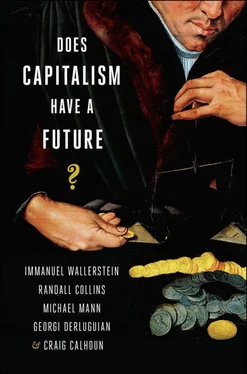A host of processes and problems will complicate the future: aging populations, explosion of medical costs, ethnic and religious conflict, ecological crisis, huge intercontinental migrations, perhaps wars of varying scope. To keep the focus on the central point: how will these affect the technological displacement crisis? Some of them will exacerbate it; some will add pressures for state breakdown and thus raise the chances of revolutions, the rolling of multiple sixes on the dice. Will any of these complications turn back technological displacement, increasing middle class employment, creating new jobs to offset automation and computerization, and in sufficient degree that capitalism will be saved? Let us consider a brief checklist of complications, with these questions in mind.
Global unevenness . The mechanisms driving capitalist crisis operate with different intensity in different countries and regions of the world. An advanced crisis of technological displacement of middle-class work in the United States or in western Europe would not necessarily coincide with the depth of such crisis in other parts of the globe—China, India, Brazil, or other places of significance in future decades. Is it possible to have a successful anticapitalist transformation inside particular states while the rest of the world remains capitalist? This would depend on the size and weight of that particular state’s economy in the world; revolutions in small states with minor economies would have little influence and might easily be overturned; those in big states with a large proportion of the world-economy would be more robust and trend-setting. Given the tendency for militarily strong regimes to intervene in other regimes, to protect their own economic interests, and to support their ideological cousins, the staggered sequence of anticapitalist regime changes could lead to interventions of the sort we have seen in the aftermath of the 2011 Arab Spring. If there were a massive economic crisis in the United States, for instance, or the EU, in the year 2030, resulting in a shift to an anticapitalist regime, possibly some other still-thriving capitalist state (China, perhaps) would intervene to stop it. Whether such interventions are successful or not will depend on geopolitical factors of relative resources, logistical extension, and geographical position [Collins 1995].
Weighing against such scenarios is a larger process: the structural crisis of capitalism is a universal tendency. Even if local hitches occur, the advance of computerization and displacement of all kinds of work will continue everywhere. No one can remain the capitalist hegemon under these conditions for long. Postcapitalist regimes, with better redistribution, may be able to generate consumer demand and get their economies back into a growth mode, pulling ahead of recalcitrant capitalist states who will be stuck in their own crises.
Muddying capitalist crisis with other dimensions of contention . In a multidimensional world, many different conflicts go on at the same time. The future showdown of capitalist crisis will be mixed with other issues; and these often have emotional and dramatic qualities that put them in the forefront of public attention.
To mention only a few: Religion —at present, contention most vehemently between militant Islamists and their opponents (Christians; Hindus; secularists of the post-Christian West; the post-Communist successor states, etc.); not ruling out the possibility of other axes of religious conflict in the future. Race/ethnicity/national identity —conflicts ranging among struggles over distribution of the spoils of office, quotas and government regulation of ethnic access to resources (affirmative action, etc.), policing borders against immigration, exclusion of immigrants, territorial disputes, and ethnic wars. But also movements to promote interethnic harmony or integration, which may be opposed in turn by movements seeking the particularistic ends listed in the previous sentence. There are also a host of transient issues that take up most of the political attention space most of the time. These involve scandals, corruption charges, personalities, atrocities, moralistic issues sometimes elevated to the status of “culture wars.” But what makes structural crises more important is that they are indeed structural; they concern inescapable conflicts in the institutional arrangements that affect the material and organizational basis of ongoing social life. Unlike scandals, structural issues do not blow over; they can be ignored for a while but they continue to produce their effects.
Overlaying by particularistic issues is inevitable. Conflicts over ethnicity, religion, gender, lifestyle, etc., can either reinforce the capitalist crisis, or muddy it enough to retard or prevent a revolutionary transformation to postcapitalism. Such conflicts could also reinforce the crisis and the transformation, if large numbers of people are mobilized via their identities as suppressed and injured ethnic groups, religions, gender, etc., and perceive their grievances as coinciding with their interests in opposing the capitalist system. Overlay of particularistic identities upon class mobilization has often happened in past revolutions, and seems likely in the future. On the other hand, the overlaying most of the time diverts attention from economic issues, and has often served as the mobilizing base for reactionary movements, opposing reform of the system because of ethnic, religious, or other hostilities to the reformers. Again we should invoke the depth of the future capitalist crisis. If it is as deep as the theory indicates, there will be no way out of it, except a postcapitalist transition. All the ethnic, religious, lifestyle, and other conflicts will only be so much noise, stringing along the crisis until finally an alignment of mobilized political forces comes about that solves the problem by postcapitalist transition. The long-term result is not whether the transition will occur, but how long it will take.
War . The capitalist crisis envisioned for the mid-21st century might well be connected with wars. Anticapitalist revolution in one state could lead to subsequent wars, as the result of outside intervention to restore a procapitalist regime; or internal civil war exacerbated and sustained by outside aid and intervention; or by another path, an aggressive post-revolutionary state promoting export of revolution, thereby generating wars elsewhere. This is not inevitable; there are pathways by which a revolution (particularly a peaceful political transition) would not be followed by wars. Rather than trying to predict the contingent variety of the future, let us ask the overarching question: would wars save capitalism, or add to its crisis? Wars on the whole promote revolutions, especially on the losing side; but also sometimes on the winning side, through war expense contributing to fiscal crisis of the state. Would a war victory by a state attempting to uphold capitalism, in a world where anticapitalist movements are strong, be able to sustain capitalism by force? It might be able to do so for a period of time. But a deep crisis of massive technological displacement of work could not be solved in this way. Even this war scenario only retards the postcapitalist transformation.
Ecological crisis . Long-term climate change, destruction of natural resources and other results of human activity are producing massive consequences and endangering life and livelihood in the future. The question is: will the ecological crisis generate shifts in capitalism, such that the capitalist crisis will be overcome (the solution to the ecological crisis solving the capitalist crisis)? Or will the crises combine, making each other worse, and thereby motivating a joint solution, or a joint failure of solution?
Читать дальше












